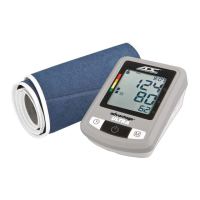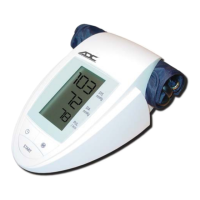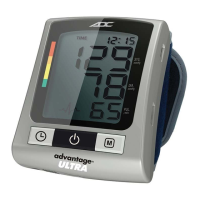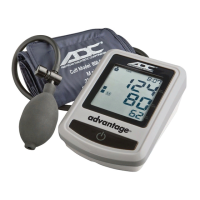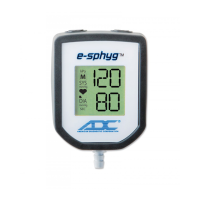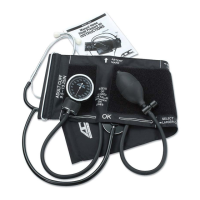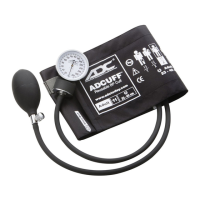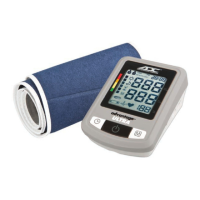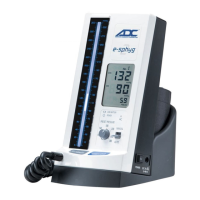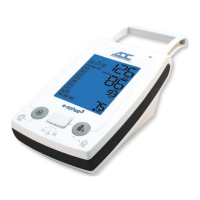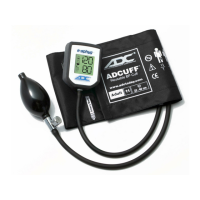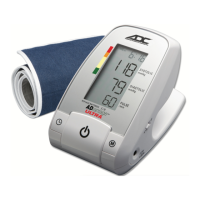
Do you have a question about the ADC Advantage 6021 and is the answer not in the manual?
| Type | Upper Arm |
|---|---|
| Cuff Material | Nylon |
| Measurement Type | Oscillometric |
| Memory | 60 readings |
| Display | LCD |
| Pulse Rate Range | 40-180 bpm |
| Power Source | 4 AA batteries or AC adapter |
Manual covers Advantage™ (6021), PLUS (6022), and ULTRA (6023) models. Device is automatic digital BP monitor.
Emphasizes professional interpretation, physician review, adult-only use, and irregular heartbeat evaluation.
Avoid strong electrical/electromagnetic fields, operate within specified temperature/humidity.
Caution for patients on dialysis/anticoagulants, use approved parts, latex-free material, avoid strangulation.
Self-measurement is for control, not diagnosis. Pulse display not for pacemaker frequency.
Explains how blood pressure arises and changes during heart activity (systolic/diastolic).
Details normal, high, and low blood pressure ranges and advises consulting a physician.
Provides advice on consulting doctors and lifestyle changes for managing blood pressure.
Identifies key parts of the measuring unit like LCD display, buttons, ports, and indicators.
Highlights features like Traffic Light Indicator (6023) and USB Port (6022, 6023).
Details the specific cuffs available for models 6021, 6022, and 6023.
Step-by-step guide for activating batteries and setting the device's date and time.
Instructions for connecting the cuff tube and choosing between Standard and Averaging measurement modes.
Guide for selecting user profiles and understanding the ADC® Averaging Mode Technology.
Advises on relaxation, avoiding exertion, and consistent measurement conditions before taking readings.
Explains factors causing inaccurate readings, such as arm position, cuff fit, and user support.
Detailed instructions on how to correctly fit the cuff on the upper arm for accurate measurements.
Step-by-step guide on how to perform a blood pressure measurement using the device.
Explains the irregular heartbeat symbol, its meaning, and when to consult a doctor.
Describes how the traffic light indicator displays blood pressure ranges (normal, pre-hypertension, hypertension).
How the monitor stores results and how to view stored measurements and the memory capacity.
Instructions for clearing all stored measurement data from the device's memory.
Procedure for interrupting a measurement in progress using the Start/ON/OFF button.
Step-by-step guide to setting up to two alarm times for medication or measurement reminders.
Explains battery indicators (almost discharged, discharged) and how to replace batteries.
Guidelines for using NiMH rechargeable batteries, including charging and removal instructions.
Instructions for connecting and using the AC adapter for continuous power.
Guide for installing ADC® Advanced PC Link Software and connecting the monitor to a PC.
Lists error codes (Err 1, Err 2, Err 3, Err 5, HI, LO) and provides possible causes and solutions.
Addresses other device malfunctions like blank display, pressure issues, inconsistent readings, and cuff pressure problems.
Instructions on cleaning, handling the cuff and tubing, and general device care.
Recommends periodic accuracy checks and details the product's warranty coverage and limitations.
Lists device standards (EN1060, AAMI/ANSI SP10) and clinical testing protocols.
Details weight, size, temperature, humidity, measuring ranges, memory, accuracy, and power sources.
Provides toll-free help line, email, and website for customer support.
